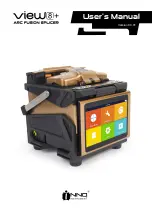
USER MANUAL
JEFTARC160-230
160A
ARC/TIG INVERTER WELDER • 230V
~
50Hz • 16A
www.jeffersontools.com
4
SAFETY GUIDELINES
Please read and ensure that you understand all of the operating instructions, safety precautions and warnings
in this Instruction Manual before operating or maintaining this equipment. An accident can often be avoided by
recognizing a potentially hazardous situation before it occurs, and by observing appropriate safety procedures.
Hazards that must be avoided to prevent bodily injury or machine damage are identified by warnings on the
equipment and in this Instruction Manual. Never use this equipment or modify it in any way that has not been
specifically recommended by the manufacturer. Contact Jefferson Tools for all information relating to the repair and
maintenance of this equipment. Contact a qualified electrician for advice on any issues relating to electrical safety
in your working environment.
ELECTRICAL SAFETY
Ensure that you check the equipment thoroughly to ensure it is safe and fit for purpose before each use. It is important that
you inspect all plugs, sockets, power cables and electrical fittings for wear and damage and repair or replace any defective
components. The risk of electric shock can be minimised by the correct use of the appropriate electrical safety devices.
•
We recommend that you fit a
Residual Current Circuit Breaker (RCCB)
in the main distribution board and that a
Residual Current Device
(RCD)
is used when operating this equipment.
•
The
Electricity at Work Act 1989
includes legislation that places legal implications on employers to ensure the safety of electrical devices
in the workplace. The regulations dictate that all portable equipment must be inspected regularly and tested to ensure that it is safe for use.
'Portable equipment' means any electrical item that can be moved and this is often referred to as
Portable Appliance Testing (PAT)
. PAT
testing should be carried out regularly on this equipment by trained, authorised personnel, as required by the legislation.
•
The
Health and Safety at Work Act 1974
states that it is the responsibility of the owner of electrical appliances to ensure that both the
equipment and working environments are maintained to ensure safe operation at all times.
•
Check that all equipment cables are secure, correctly insulated, free from damage, and protected against short circuit and overload before
connecting to the power supply. Do not use worn or damaged cables, plugs, sockets or other fittings.
•
Ensure that the power supply matches voltage requirements specified on the equipment.
•
Ensure the power cable is kept away from heat, oil and sharp edges.
•
Always disconnect the equipment from the power source before servicing, inspecting, maintaining, cleaning, replacing or checking any parts.
•
Do not carry the equipment while it is connected to its power source.
•
Do not use this equipment in damp or wet conditions or environments with high condensation.
•
Do not touch live electrical parts.
•
Wear dry protective clothing (free from oil or other flammable residues).
•
Avoid contact with work piece or ground during welding.
•
Do not touch the work piece & welding wire at the same time.
•
Use only the cables and rods recommended by the manufacturer.
•
Always disconnect from the mains before carrying out any service or maintenance on this equipment.
•
Use AC output ONLY if required for the welding process. If AC output is required, use remote output control if present on unit.
•
Protect yourself from electric shock by insulating yourself from work and ground using dry rubber mats, dry wood or plywood, or other dry
insulating material big enough to cover the full working area.
Summary of Contents for JEFTARC160-230
Page 1: ...User Manual v 1 1 JEFTARC160 230...
Page 2: ......


































